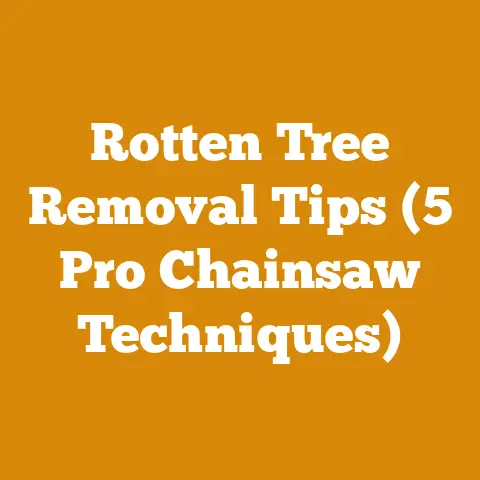How to Transplant Trees from Woods (5 Pro Tips for Healthy Growth)
Have you ever looked at a majestic tree in the woods and thought, “I wish I could have that in my yard?” The idea of transplanting trees from the wild seems appealing, especially when you want to add mature beauty to your landscape quickly. However, it’s not as simple as digging up a tree and plopping it into a new hole. Transplanting trees successfully requires careful planning, the right techniques, and a good understanding of tree physiology. As someone deeply involved in wood processing, logging, and firewood preparation, I’ve learned a thing or two about trees – what makes them thrive, and how to handle them with care. Today, I’ll share five pro tips to help you transplant trees from the woods and ensure their healthy growth.
How to Transplant Trees from Woods (5 Pro Tips for Healthy Growth)
Before we dive into the practical tips, let’s address why this topic is relevant to wood processing and firewood preparation. While we often think of these activities as involving felling trees, understanding tree health and survival is crucial for sustainable forestry practices. Knowing how to transplant trees successfully allows us to mitigate the impact of logging by relocating valuable specimens or re-establishing tree cover in cleared areas. It also provides a deeper appreciation for the life cycle of trees, informing our approach to wood processing and firewood selection.
Tip #1: Timing is Everything: Selecting the Right Season
The time of year you choose to transplant a tree can significantly impact its survival rate. The best times are generally during the dormant seasons: late fall or early spring.
- Late Fall (after leaf drop): The tree has already prepared for winter, its energy is stored in the roots, and the cool temperatures reduce stress during the transplant. This is my preferred time for most deciduous trees.
- Early Spring (before bud break): The tree is just beginning to emerge from dormancy, and the roots can establish themselves before the demands of new leaf growth become too great.
Why Timing Matters:
During the growing season, trees are actively photosynthesizing and transpiring water. Digging up a tree at this time disrupts its root system, hindering its ability to absorb water and nutrients. This can lead to transplant shock, a condition where the tree struggles to survive due to the stress of being moved.
My Experience:
I once attempted to transplant a small maple sapling in the middle of summer. Despite my best efforts, the tree quickly wilted and died. It was a harsh lesson in the importance of timing. Since then, I’ve always adhered to the fall or spring transplanting windows.
Considerations:
- Climate: In regions with mild winters, fall transplanting is often the best option. In colder climates, spring transplanting may be preferable to avoid root damage from freezing temperatures.
- Tree Species: Some tree species are more tolerant of transplanting than others. Consult local nurseries or arborists for specific recommendations.
Tip #2: Root Ball is King: Digging for Success
The root ball is the mass of roots and soil that you dig up with the tree. The size and integrity of the root ball are critical for the tree’s survival after transplanting.
- Size Matters: A general rule of thumb is to dig a root ball that is 10-12 inches in diameter for every inch of trunk diameter. For example, a tree with a 2-inch trunk diameter should have a root ball that is 20-24 inches in diameter. This ensures you capture a sufficient amount of the tree’s root system.
- Shape is Important: Aim for a round or slightly tapered root ball. Avoid digging a shallow, wide root ball, as this can damage the deeper roots.
The Digging Process:
- Mark the Root Ball: Before you start digging, use a shovel or garden fork to mark the circumference of the root ball.
- Dig a Trench: Dig a trench around the marked circle, gradually working your way down.
- Undercut the Root Ball: Once you’ve reached a depth of about 18-24 inches (depending on the size of the tree), carefully undercut the root ball, severing any remaining roots.
- Wrap the Root Ball: Immediately wrap the root ball with burlap or a tarp to prevent it from drying out and falling apart. Secure the burlap with twine.
Tool Specifications:
- Shovel: A sturdy, round-point shovel is essential for digging the trench and undercutting the root ball.
- Garden Fork: A garden fork can be helpful for loosening the soil around the roots.
- Burlap or Tarp: Use a breathable material like burlap to wrap the root ball. Avoid using plastic, as it can trap moisture and lead to root rot.
- Twine: Natural twine is best for securing the burlap, as it will eventually decompose in the soil.
Case Study: Saving a Stranded Oak Sapling
I once helped a friend clear a plot of land for a garden. We discovered a small oak sapling growing in an inconvenient location. Instead of simply cutting it down, we decided to transplant it to a more suitable spot. We carefully dug a root ball that was about 18 inches in diameter and 18 inches deep, wrapped it in burlap, and moved it to its new home. The sapling thrived and is now a beautiful addition to my friend’s property.
Why a Good Root Ball Matters for Firewood:
Believe it or not, the root ball also impacts future firewood potential. A tree that establishes itself quickly after transplanting will grow faster and healthier, ultimately producing more firewood in the long run if it’s a species suitable for burning.
Tip #3: Prepare the New Home: Soil and Location
The success of your transplant depends not only on how you dig up the tree but also on the conditions you provide in its new location.
- Location, Location, Location: Choose a location that is similar to the tree’s original habitat. Consider factors such as sunlight exposure, soil type, and drainage.
- Dig a Wide Hole: The planting hole should be at least twice as wide as the root ball and slightly shallower. This allows the roots to spread easily and encourages new growth.
- Amend the Soil: If the soil in your yard is poor, amend it with compost or other organic matter. This will improve drainage, aeration, and nutrient content.
Soil Types and Their Impact:
- Sandy Soil: Drains quickly but doesn’t retain moisture well. Amend with compost and peat moss to improve water retention.
- Clay Soil: Retains moisture but can become compacted and poorly drained. Amend with compost and sand to improve drainage.
- Loamy Soil: A well-balanced mixture of sand, silt, and clay. Generally considered the ideal soil type for most trees.
My Insights on Soil Preparation:
I’ve learned that a little extra effort in soil preparation goes a long way. I always add a generous amount of compost to the planting hole and mix it thoroughly with the existing soil. This provides the tree with a slow-release source of nutrients and helps it establish itself quickly.
Benefits of Proper Site Selection:
A well-chosen location minimizes stress on the transplanted tree, leading to faster establishment and healthier growth. It also reduces the need for supplemental watering and fertilization.
Relating to Wood Processing:
Understanding soil types and their impact on tree growth is crucial for sustainable forestry practices. Knowing which tree species thrive in different soil conditions allows us to make informed decisions about reforestation and timber harvesting.
Tip #4: Planting and Care: The First Year is Critical
The first year after transplanting is the most critical period for the tree’s survival. Proper planting and ongoing care are essential to ensure its successful establishment.
- Planting Depth: Place the tree in the hole so that the top of the root ball is level with the surrounding soil. Planting too deep can suffocate the roots.
- Backfill Carefully: Gently backfill the hole with the amended soil, tamping it down lightly to remove air pockets.
- Water Thoroughly: Water the tree deeply immediately after planting. This helps settle the soil and provides the roots with the moisture they need to establish themselves.
- Mulch Generously: Apply a 2-4 inch layer of mulch around the base of the tree, keeping it a few inches away from the trunk. Mulch helps retain moisture, suppress weeds, and regulate soil temperature.
- Water Regularly: Water the tree regularly during the first year, especially during dry periods. Check the soil moisture by inserting your finger a few inches into the ground. If the soil feels dry, it’s time to water.
- Fertilize Sparingly: Avoid fertilizing the tree during the first year unless the soil is extremely poor. Over-fertilizing can burn the roots and hinder establishment.
Watering Strategies:
- Deep Watering: Water deeply and infrequently rather than shallowly and frequently. This encourages the roots to grow deeper into the soil.
- Soaker Hose: A soaker hose is an excellent way to water newly transplanted trees, as it delivers water slowly and directly to the roots.
Mulch Types and Their Uses:
- Wood Chips: A readily available and inexpensive mulch option. Decomposes slowly and provides long-lasting benefits.
- Shredded Bark: A visually appealing mulch that also helps retain moisture and suppress weeds.
- Pine Needles: A good choice for acidic-loving plants, as they help lower the soil pH.
My Success Story:
I transplanted a small dogwood tree to my backyard a few years ago. I followed all the steps outlined above, including careful planting, thorough watering, and generous mulching. The tree thrived and now provides beautiful blooms every spring.
Firewood Connection:
Proper care of young trees is essential for ensuring a sustainable supply of firewood in the future. By promoting healthy growth, we can maximize the yield of firewood from our forests and woodlots.
Tip #5: Protect from the Elements: Staking and Protection
Newly transplanted trees are vulnerable to wind damage, animal browsing, and sunscald. Taking steps to protect them from these elements can significantly improve their chances of survival.
- Staking: Stake the tree if it is tall or exposed to strong winds. Use two or three stakes placed around the tree and attach them to the trunk with soft ties. Remove the stakes after one year, once the tree has established a strong root system.
- Animal Protection: Protect the tree from deer and other animals by installing a wire cage or tree guard around the trunk.
- Sunscald Protection: Wrap the trunk of young trees with burlap or tree wrap to protect them from sunscald, especially during the winter months.
Staking Techniques:
- Soft Ties: Use soft, flexible ties to avoid damaging the bark of the tree.
- Loose Fit: Allow the tree to move slightly in the wind. This helps it develop a stronger trunk.
Animal Deterrents:
- Deer Repellents: Apply deer repellent to the foliage of the tree to deter browsing.
- Physical Barriers: Install a wire cage or tree guard around the trunk to prevent animals from reaching the tree.
Sunscald Prevention:
- Burlap Wrap: Wrap the trunk of the tree with burlap to protect it from the sun’s rays.
- Tree Wrap: Use commercially available tree wrap, which is designed to protect the trunk from sunscald and other environmental factors.
My Practical Tips:
I’ve found that a combination of staking, animal protection, and sunscald protection is the most effective way to ensure the survival of newly transplanted trees. I always install a wire cage around the trunk of my trees to protect them from deer and other animals.
Relating to Firewood Storage:
The principles of protecting trees from the elements are similar to those used for storing firewood. Just as trees need protection from wind, animals, and sunscald, firewood needs protection from rain, snow, and insects. Proper storage techniques can help prevent rot and decay, ensuring that your firewood is ready to burn when you need it. I always cover my firewood stacks with a tarp to keep them dry and prevent moisture from seeping in. This helps preserve the wood’s energy content and makes it easier to ignite.
Green Wood vs Seasoned Wood:
Speaking of firewood, it’s important to understand the difference between green wood and seasoned wood. Green wood is freshly cut wood that has a high moisture content. Seasoned wood, on the other hand, has been allowed to dry for several months or even a year, reducing its moisture content. Seasoned wood burns much more efficiently and produces less smoke than green wood.
Why Seasoning Matters:
- Higher Heat Output: Seasoned wood has a lower moisture content, which means more of the wood’s energy is released as heat when it burns.
- Less Smoke: Green wood produces a lot of smoke, which can be harmful to your health and the environment. Seasoned wood burns cleaner and produces less smoke.
- Easier to Ignite: Seasoned wood is much easier to ignite than green wood.
Drying Methods:
- Air Drying: The most common method of seasoning firewood. Stack the wood in a well-ventilated area and allow it to dry for several months.
- Kiln Drying: A faster method of seasoning firewood. The wood is placed in a kiln and heated to remove moisture.
Moisture Content Targets:
The ideal moisture content for firewood is between 15% and 20%. You can use a moisture meter to check the moisture content of your firewood.
Safety Considerations:
When handling firewood, it’s important to wear gloves and eye protection to protect yourself from splinters and debris. Use a log splitter to split large pieces of wood safely.
Chainsaw Safety:
As someone who uses chainsaws regularly for logging and firewood preparation, I cannot overemphasize the importance of safety. Always wear appropriate personal protective equipment (PPE), including a helmet, eye protection, hearing protection, gloves, and chainsaw chaps. Inspect your chainsaw before each use and ensure that it is in good working condition. Use proper felling techniques and be aware of your surroundings.
Felling Techniques:
- Directional Felling: Use wedges and felling levers to control the direction of the fall.
- Hinge Wood: Leave a hinge of wood connecting the stump to the tree to control the fall.
Debarking Logs:
Debarking logs can help speed up the drying process and reduce the risk of insect infestation. Use a drawknife or debarking spud to remove the bark.
Splitting Firewood:
- Manual Splitting: Use a splitting axe or maul to split firewood manually.
- Hydraulic Splitter: A hydraulic splitter can make the job of splitting firewood much easier and safer.
Firewood Stacking:
Stack your firewood in a way that allows for good air circulation. This will help it dry more quickly.
Stacking Methods:
- Crisscross Stacking: Stack the wood in a crisscross pattern to create a stable and well-ventilated stack.
- Holz Hausen: A traditional German method of stacking firewood in a circular pattern.
Cost and Material Specs:
The cost of firewood varies depending on the location and the type of wood. Hardwoods, such as oak and maple, are generally more expensive than softwoods, such as pine and fir.
Skill Levels Required:
The skill level required for wood processing and firewood preparation varies depending on the task. Felling trees requires a high level of skill and experience. Splitting firewood can be done by beginners with proper safety precautions.
Strategic Advantages:
By understanding the principles of wood processing and firewood preparation, you can become more self-sufficient and save money on heating costs. You can also contribute to a more sustainable environment by using locally sourced firewood.
Next Steps:
Now that you have a better understanding of how to transplant trees from the woods and the principles of wood processing and firewood preparation, you can start your own projects. Start small and gradually increase the complexity of your projects as you gain experience.
Conclusion:
Transplanting trees from the woods can be a rewarding experience, allowing you to bring mature beauty to your landscape. By following these five pro tips, you can increase your chances of success and ensure the healthy growth of your transplanted trees. Remember that patience and persistence are key. It takes time for a transplanted tree to establish itself and thrive. But with proper care and attention, you can enjoy the beauty and benefits of your new tree for years to come. Furthermore, the insights gained from understanding tree health translate directly into more sustainable and efficient wood processing and firewood preparation practices.






